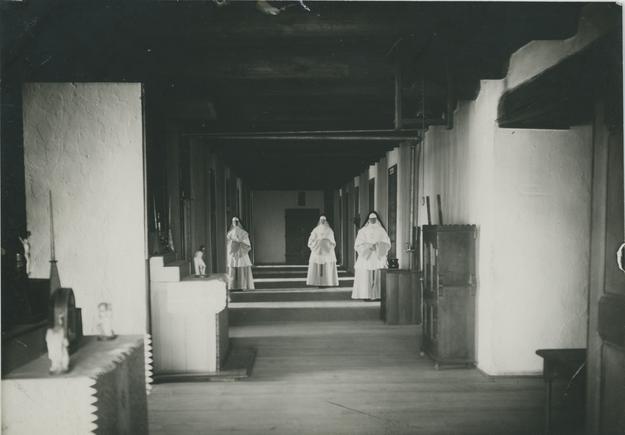At the Sound of the Bell… and the Rattle
In the past, life at the monastery was organized according to a well-established rhythm, meeting the customary[1] requirements. Silence, which permeated every area of the monastery, was regularly broken by the resounding sound of different bells.

Photograph showing the dormitory corridor of the Garden Wing, early 20th century. On the right, there is a bell hanging from the ceiling. (HDQ-F1-N1,2/7:1)
© Archives du Monastère des Augustines
Fonds Monastère des Augustines de l’Hôtel-Dieu de Québec
The language of the bells
The ringing of the bells was a regular fixture throughout the nuns’ days. The monastery’s many bells had a language that the novices quickly learned. By 4 a.m., the bell of the dormitory and that of the choir filled the air with the sound of a “Pater” and an “Ave” (Our Father and Hail Mary). Similarly, prayer, the conventual Mass, the dinner of the poor, the rosary, gospel reading, the community supper and so on each had its distinctive ringtone. The day ended at sunset at 8:45 p.m., while the community bell was rung for a “De Profundis” (Psalm 130).
Bell usage norms were also prescribed on solemn holidays. During Holy Week, for example, the bells were said to have “gone to Rome,” from Holy Thursday to Easter Sunday. This tradition, still prevalent among Catholics, allowed the Augustinian Sisters to commemorate the death of Jesus in contemplation and silence. Although the bells remained physically in the monastery, they were not used during this period. The rattle then replaced them for services as well as to announce the different moments of the day, including waking up.

Wood, 20th century
© Collections du Monastère des Augustines
Hôtel-Dieu de Québec
Bells that are now silent
Several bells were reinstalled when rehabilitating the old buildings of the current Le Monastère des Augustines; each of them having a specific function. The tour’s bell, for example, was used to inform the nun in attendance at the convent’s tour of the delivery of a parcel or the arrival of a visitor. The cloister bell was activated when doctors or hospital staff entered the cloister. Ringing this bell made it possible to inform the nuns of the presence of these visitors. The nuns then had to cover their faces with their veil. Finally, the two observance bells made it possible to signal certain moments of the day, like waking up, the religious services and the meals.

Wood, metal, iron cast, 19th century
© Collections du Monastère des Augustines
Hôtel-Dieu de Québec
Although they were an integral part of the building, these bells are considered pieces of the collection of the monastère de l’Hôtel-Dieu de Québec. This explains why they are no longer rung. In spite of not hearing them, they are now attracting the eye of visitors walking through the corridors of the Monastery. Le Monastère. In addition, some hand bells and a rattle are now on display at Le Musée du Monastère des Augustines.

© Collections du Monastère des Augustines
[1] Coutumier des Moniales Hospitalières de Saint-Augustin, 1916.

